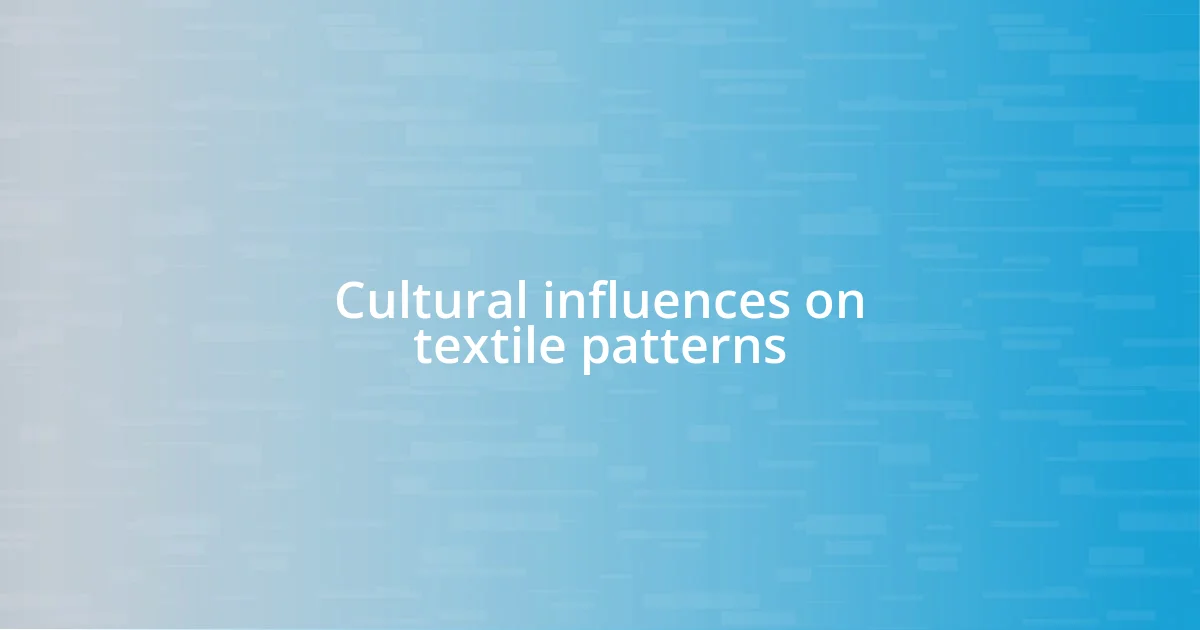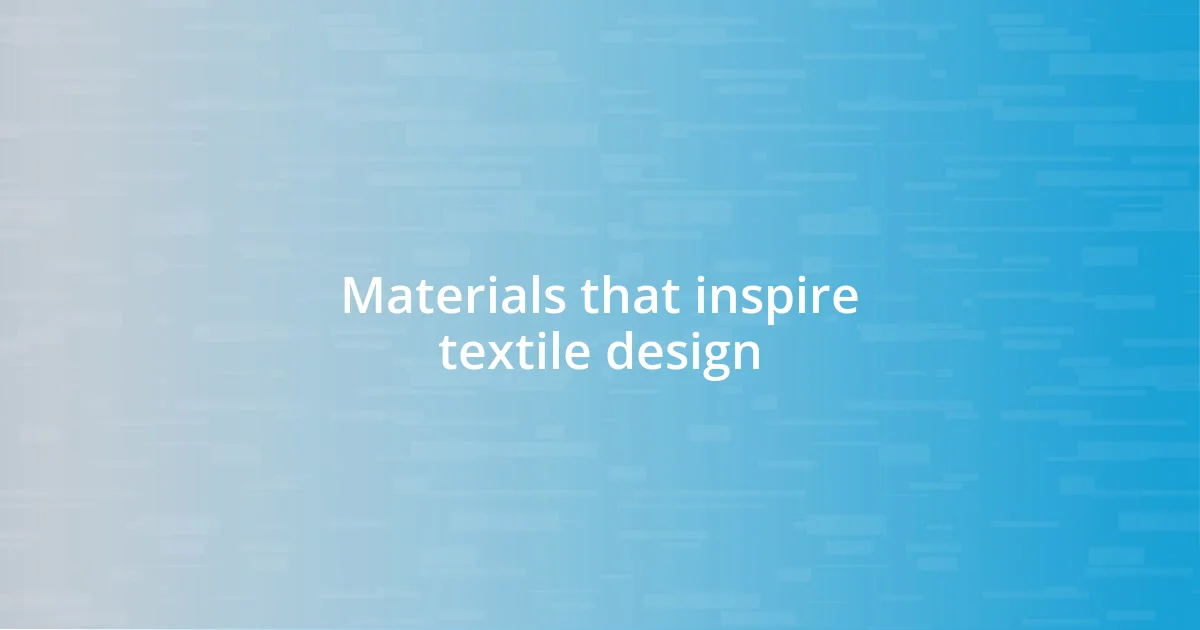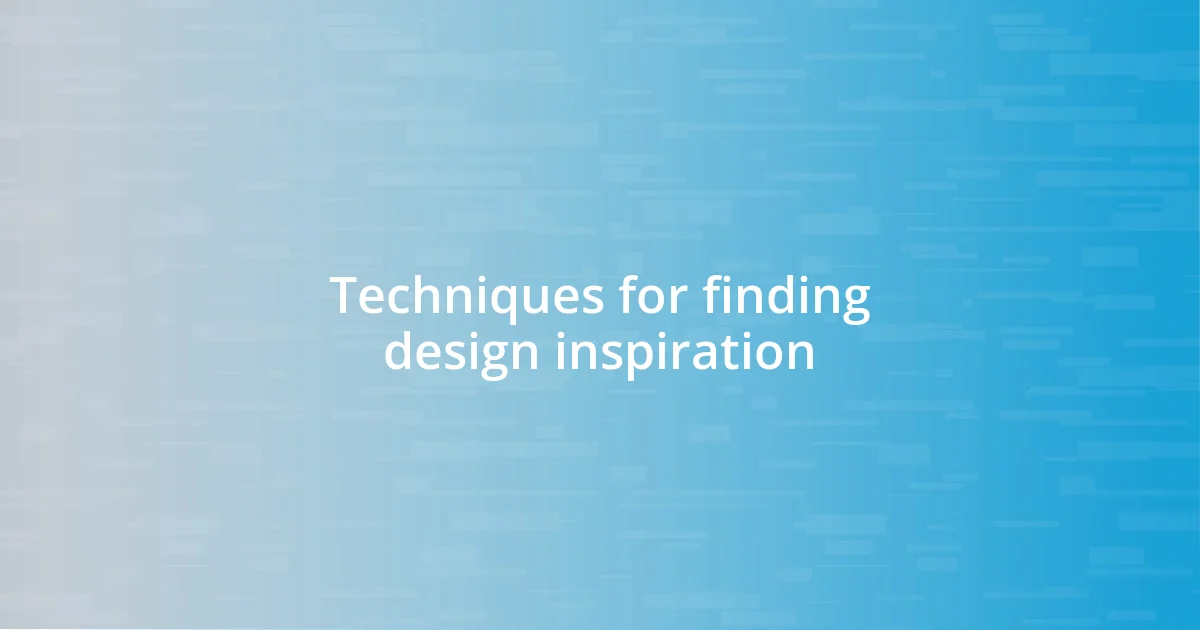Key takeaways:
- Textile design inspiration can stem from various sources, including nature, personal experiences, and cultural influences, highlighting the emotional connection to textiles.
- Historical references and techniques from different cultures inform modern design, illustrating how traditional narratives and practices enrich contemporary work.
- Active engagement with the environment, such as maintaining an inspiration journal and collaborating with other artists, can unlock new creative avenues and ideas.

Understanding textile design inspiration
Textile design inspiration can often come from the world around us, filled with colors, textures, and patterns that evoke emotions. I remember strolling through a vibrant market in Marrakech, where the rich hues of the woven fabrics sparked an idea for a collection celebrating cultural heritage. Isn’t it fascinating how a single moment can ignite a whole creative journey?
Exploring nature is another profound source of inspiration for textile design. I often find solace in my garden, where the play of light on leaves and the subtle shifts in color throughout the seasons remind me of the beauty and intricacy of life. Have you ever taken a moment to really look at how nature combines soft pastels with bold shades? It’s a brilliant lesson in harmony and contrast.
Moreover, historical textiles tell stories that can influence modern design choices. When I discovered a collection of antique patterns at a local museum, I was struck by the craftsmanship and significance behind each piece. How do these past stories shape our present design landscape? They remind us that every thread has a narrative, and understanding these narratives can infuse our work with deeper meaning.

Personal experiences influencing design
I often reflect on my childhood summer trips to my grandmother’s home, where she transformed her living space with handmade quilts. The warmth and love infused in those textiles left an indelible mark on my creative mind. Each stitch seemed to carry echoes of stories and laughter, making me appreciate the emotional connection that textiles can embody in design.
There was one evening I spent watching the sunset over a vineyard. The way the colors shifted from oranges to deep purples was nothing short of mesmerizing. I found myself sketching those hues later that night, inspired to create a collection that captured that fleeting beauty. It’s amazing how fleeting moments can inspire designs that evoke powerful feelings and memories in others, don’t you think?
Traveling through various cultures has opened my eyes to different weaving techniques and styles. I recall visiting a small workshop in India, where artisans taught me the significance of patterns rooted in local mythology. Engaging with these craftspeople gave me a profound appreciation for how personal experiences and traditions inform textile design. The connection between art and life became clearer, shaping my vision as a designer.
| Personal Experience | Impact on Design |
|---|---|
| Childhood quilts from grandmother | Emphasizes emotional connection to textiles |
| Sunset over a vineyard | Inspires color palettes and themes |
| Workshop in India | Deepens understanding of cultural significance |

Nature’s role in textile creativity
Nature plays an incredibly vital role in textile creativity. I remember a hike through a dense forest where I was captivated by the rich variety of textures, from the smoothness of moss to the ruggedness of tree bark. Each detail inspired a new idea for fabric patterns that mirror the complexity of natural forms. The experience reminded me that the organic world not only influences our aesthetics but also our emotional responses in design.
Here’s how nature can influence textile creativity:
- Color Palettes: Observing flora and fauna introduces a stunning range of colors, from the lively greens of spring leaves to the muted browns of autumn.
- Texture Inspiration: The tactile variety found in nature pushes designers to explore and replicate textures, from the soft silkiness of petals to the coarse fibers of natural fibers.
- Patterns: The intricate patterns of animal skins and plant growth can lead to original designs that resonate with organic beauty and fluidity.
- Movement: Watching leaves flutter in the wind can inspire designs that reflect movement, giving life to static textiles.
- Symbolism: Nature often carries deep meanings and cultural connections which can be woven into textiles for added depth.
There’s something truly meditative about stepping outside and letting nature envelop your senses. When I’m surrounded by blooming flowers or an expansive landscape, I can’t help but jot down ideas for patterns that reflect that beauty. Whether it’s a gentle breeze or the vibrant hues of a sunset, these experiences connect me to my work deeply, reminding me that our surroundings hold endless inspiration for creativity.

Cultural influences on textile patterns
Cultural influences on textile patterns are fascinating, reflecting the values and aesthetic preferences of different societies. During my travels in Morocco, I encountered beautiful handwoven textiles adorned with geometric designs and vibrant colors. Each pattern told a story of the region’s history, representing concepts like protection and fertility that resonate deeply within the local community. Isn’t it amazing how a simple fabric can serve as a canvas for such profound narratives?
I also remember sitting in a bustling marketplace where I was drawn to a tapestry featuring intricate floral motifs inspired by ancient Persian art. The artisans explained that each flower held specific symbolism, often linked to local folklore and spirituality. This interaction reminded me of the power textiles have to transcend language and connect us to traditions that may otherwise be lost. Have you ever felt that connection through a piece of fabric?
In contrast, my visit to a tribal village in Africa revealed how colors and patterns can signify status and heritage. The bold, contrasting hues worn during ceremonies created an authentic visual language meant to convey identity and ancestral ties. It struck me how these textiles serve not only as clothing but as living history, weaving together generations of culture into every stitch. The realization that everyday fabric can carry such rich narrative and significance continues to inspire my designs today.

Historical references in textile work
Historical references in textile work can serve as an incredible wellspring of inspiration. I recall flipping through an art history book where I stumbled upon intricate tapestries from the medieval period, depicting tales of chivalry and nature. The vibrant colors and detailed storytelling sparked my imagination and reminded me that textiles can encapsulate whole narratives, evoking emotions tied to the eras they represent. Have you ever felt transported to another time just by the colors or patterns in a fabric?
As I grew more interested in textile design, I began exploring the rich heritage of Japanese indigo dyeing, which dates back centuries. The meticulous craftsmanship and cultural significance behind each piece struck a chord with me. It’s fascinating how each indigo design, often inspired by nature or mythology, tells a story of patience and respect for tradition. Every stitch and shade of blue feels like a conversation with history, inviting me to honor those who walked this creative path before. Have you ever pondered the stories woven into the very fibers of your favorite textiles?
The revival of ancient weaving techniques also inspires me profoundly. I remember visiting a local artisan who specialized in incorporating traditional Peruvian patterns into modern designs. Watching her work was a revelation; the vibrant colors and geometric shapes were deeply rooted in Incan culture. It made me appreciate how art has a cyclical nature—infusing contemporary textiles with historical references not only keeps traditions alive but breathes new life into them. Have you ever felt the pulse of history in a piece of fabric, connecting you to a time you never lived?

Materials that inspire textile design
When it comes to materials that inspire textile design, I find myself constantly enchanted by natural fibers. I once had the chance to work with organic cotton, and the softness just captivated me. The way it drapes and breathes feels alive, almost as if it has a personality of its own. Isn’t it remarkable how a natural material can transform into something so elegant yet comfortable?
Another material that has profoundly influenced my designs is silk. I remember the first time I touched a silk scarf—its luxurious sheen felt like a gentle caress against my skin. The way it reflects light creates stunning visual effects, making every garment appear like a work of art rather than just an outfit. I often wonder how something so delicate can evoke such strength and confidence when worn. Have you ever experienced that feeling when wearing silk?
Then there’s linen, a fabric with such a rich history. I recall visiting a small workshop where artisans were handweaving linen, and the earthy scent of the fibers was intoxicating. It’s fascinating how versatile linen is; it exudes a casual elegance that feels comfortable in any setting. Each time I design with linen, I’m reminded of its connection to tradition and sustainability. Do you think the materials we choose can influence not just the design, but also our emotions and experiences?

Techniques for finding design inspiration
Finding design inspiration can often feel like a treasure hunt, and one technique I love is incorporating nature into my creative process. I fondly remember a hike through a vibrant forest, where the interplay of leaves, shadows, and sunlight ignited my imagination. Each shade of green and burst of color spoke to me, leading me to explore botanical motifs in my designs. Have you ever noticed how a simple walk outdoors can shift your perspective and spark fresh ideas?
Another method I’ve found effective is maintaining an inspiration journal. I started this habit during a particularly stagnant phase in my creative journey. Each time I encountered an interesting texture, color, or concept, I jotted it down, along with sketches or snippets of thoughts. The act of documenting these moments created a visual and emotional map that I could refer back to when I needed a nudge. Isn’t it fascinating how our own reflections can provide a wellspring of ideas we might overlook in the chaos of daily life?
Collaborating with fellow artists also nourishes my creativity significantly. I recall a collaborative project where I worked alongside a painter. Her bold colors and abstract forms encouraged me to push my own boundaries in textile design. That experience taught me that every interaction can unlock new avenues of inspiration. Have you ever found that sharing your creative process with someone else opened doors you didn’t even know existed?
















